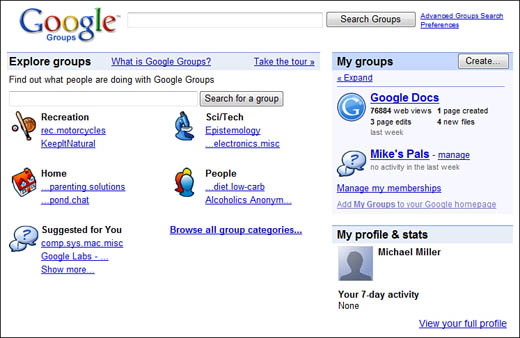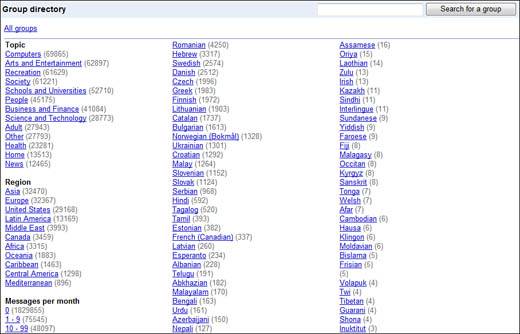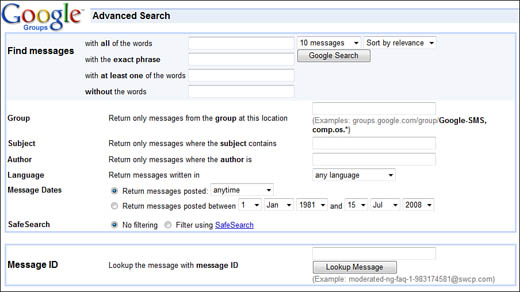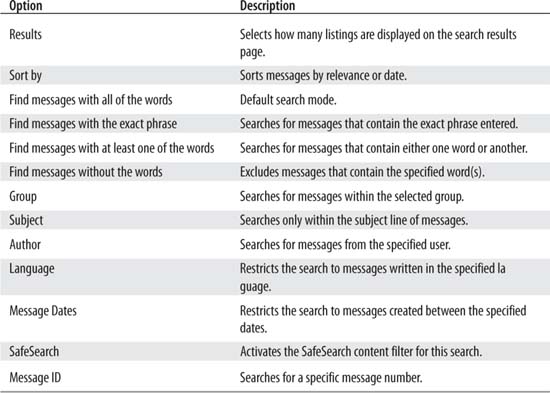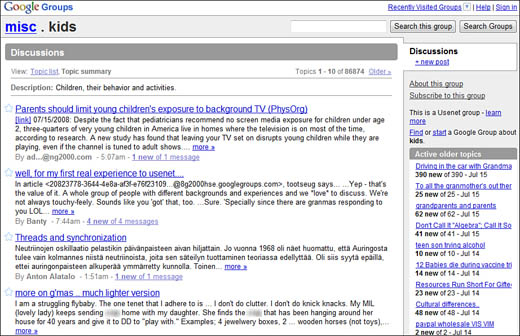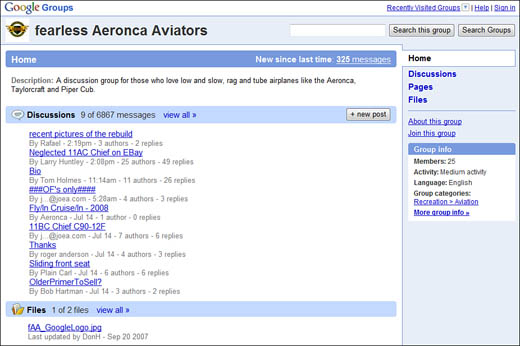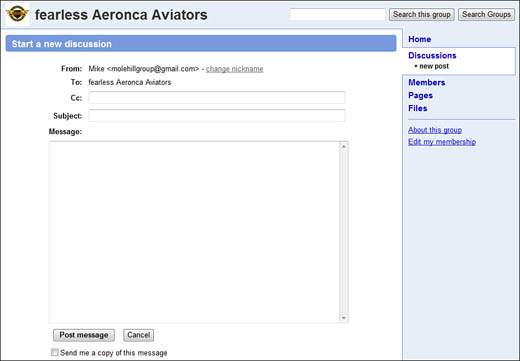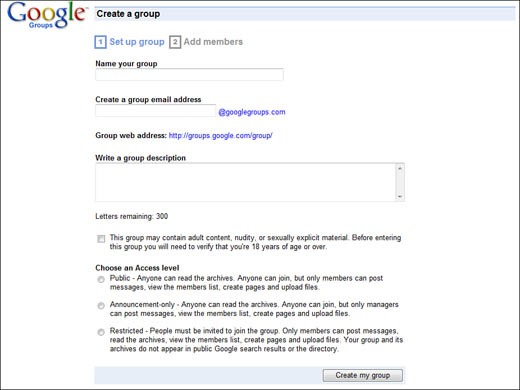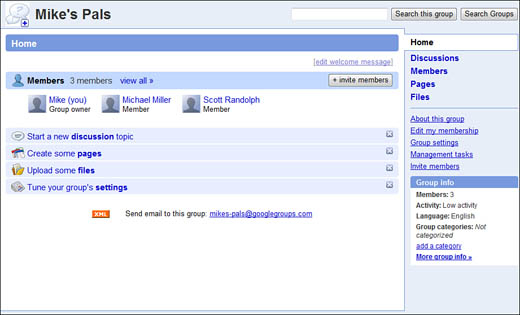The history of Google Groups starts with Usenet. Predating the World Wide Web—but still using the Internet’s underlying infrastructure—Usenet is a collection of more than 30,000 online discussion groups, organized by topic. Usenet ties into Google via Google Groups, which functions as a newsreader for Usenet newsgroups and an archive of historical newsgroup postings—as well as a host of thousands of user-created (non-Usenet) discussion groups.
Usenet is a network that piggybacks on the larger Internet. In fact, it was one of the first components of the Internet, predating the Web and the so-called public Internet. The Usenet network is designed to host and convey messages from users organized around topic categories called newsgroups.
In essence, a Usenet newsgroup is an electronic gathering place for people with similar interests. Within a newsgroup, users post messages (called articles) about a variety of topics; other users read these articles and, when so disposed, respond. The result is a kind of ongoing, freeform discussion in which dozens—or hundreds—of interested users can participate.
Usenet is a kind of living beast, with new articles being posted daily and old articles fading into the ether. Except that you really don’t want those old articles fading away, because they contain (among the expected chaff, of course) some very important discussions and information that simply don’t exist anywhere else on the Internet.
For that reason, there have long been attempts to archive historical Usenet postings. The most successful of these archives was DejaNews (later called Deja.com), which Google purchased in 2001. Google subsequently turned DejaNews into Google Groups, which continues to function as both an archive of historical Usenet articles and a Web-based newsreader for current Usenet newsgroups. You can use Google Groups to search the newsgroup archives or to browse the current messages in any Usenet newsgroup.
Note
Unlike some Web-based discussion forums or blogs, most Usenet newsgroups are unmoderated, meaning that no one’s watching the message content to ensure that subject discussions stay on track. The result is a kind of only slightly organized chaos, typically with a lot of off-topic messages and thinly concealed advertisements mixed in with the on-topic and useful messages.
Today, Google Groups is more than just Usenet. Yes, Google Groups continues to serve as a Usenet newsreader and as a comprehensive Usenet archive, but it’s also home to thousands of user-created discussion groups that have nothing to do with Usenet. When you search Google Groups today, you’re searching both Usenet postings and postings made within these user-created groups; as far as Google Groups is concerned, one type of group is just as good as the other.
In the past, you had to use a newsreader program to browse through Usenet newsgroups and read individual newsgroup articles. This was fine for the time, and it was marginally acceptable if you were only interested in following a handful of newsgroups. But it just didn’t cut it if you were power-searching for specific information across multiple newsgroups. For that, you need a more powerful tool, a true Usenet search engine—which is where Google Groups comes in.
You access Google Groups, shown in Figure 16.1, by going directly to groups.google.com. From here you can search for specific groups, browse through available groups, or search all groups for specific information.
When you want to read the current articles or postings in a specific group, you start by searching for that group. To conduct a group search, go to the Explore Groups section of the Google Groups page, enter your query, and then click the Search for a Group button.
The search results page, shown in Figure 16.2, lists several different items. At the top of the page is a series of filters you can click to list only those matching groups within a specific topic, language, activity level, or size (number of members). Below that is a list of the groups themselves, listed in order of activity (high to low).
For each group, Google lists the group name, the group’s language, the group’s activity level and number of users, and whether it’s a Usenet newsgroup. (If the word “Usenet” doesn’t appear, it’s a user-created Google Group.)
You can also browse for groups by category. Just scroll down to the bottom of the Google Groups page and click the Browse All Group Categories link. This displays the Group Directory, shown in Figure 16.3. Click through a major category and through the various subcategories until you find the specific group you want.
If, instead of reading the messages in a specific group, you want to search for messages about a given topic across all groups, you can do that. Searching the Google Groups archive is as simple as entering a query into the search box at the top of the Google Groups page and then clicking the Search button.
This displays a list of individual messages that match your search criteria. Click a message header to read that message, or click the group name below that message to go to the hosting group.
When you’re searching for messages across groups, you can use any of three Groups-specific advanced search operators to fine-tune your search, as shown in Table 16.1. Just enter the operator into the search box.
Google Groups also offers a Groups Advanced Search page, shown in Figure 16.4, which lets you fine-tune your search from a simple web form. You access this page by clicking the Advanced Groups Search link on the Google Groups page.
Table 16.2 details the search options available on the Groups Advanced Search page.
Make your choices, and then click the Google Search button to initiate the search.
As soon as you find a group you like, you have a couple of options. You can opt to visit the group and read messages on an infrequent basis, or you can subscribe to the group so that you’re notified when new messages are posted.
To view any Google group, all you have to do is search for or browse to the group, and then click the group name. This displays the group’s main page.
If you’re viewing a Usenet newsgroup, the page looks like the one shown in Figure 16.5. On this page you see a list of the most recent topics (in Usenet parlance, “threads”), with a snippet of the most recent message in each thread. A list of older topics is displayed in the right column. If you like, you also can search the messages within this group by using the search box at the top of the page and clicking the Search This Group button.
On the other hand, if you’re viewing a Google Groups group, you see a page like the one shown in Figure 16.6. A list of the most recent topics (in Google parlance, “discussions”) is on the left side of the page; a full list of topics can be had by selecting the Discussions tab on the right side of the page. Groups can also contain specialized pages (on the Pages tab) and files for downloading (on the Files tab).
Whichever type of group you’re visiting, you can read all the messages on a given topic (in a given thread or discussion, that is) by clicking the title of the thread. This displays the message page, like the one shown in Figure 16.7. Messages are listed in chronological order (the first message at the top and the last at the bottom).
If you want to keep up-to-date on all the new messages in a group, you may want to join that group. When you join a group, you’re automatically notified of new messages posted to the group via email; you don’t have to visit the group page to read messages.
To subscribe to a group, just go to the main group page and then click the Join This Group link on the right side of the page. When the Join page appears, select how you want to be notified of new messages:
-
No Email. You aren’t informed of new messages; you have to go to the Google Groups site to read the group’s messages.
-
Abridged Email. You get one email a day that summarizes all the new messages.
-
Digest Email. You get one or more emails a day containing the full text of up to 25 messages. If a group has more than 25 messages in a day, you receive additional digest emails containing the excess messages.
-
Email. Each new message in the group is sent to you via email as it is posted.
After you’ve made your selection, enter the nickname you want to use, and then click the Join This Group button.
As soon as you’re on a group page, you have the option of simply reading messages, replying to messages, or posting a message on a new topic.
To reply to a message, start by opening the message thread. At the bottom of each message in the thread is a Reply link. When you click this link, the page expands to show a Reply box. Enter your reply into the box, and then click the Post button. Your reply is added to the end of the current thread.
You’re not limited to replying to existing message topics. You can also start a new message thread (also called a discussion) with a new message.
Tip
To unsubscribe from a group, go to that group’s page, click the Edit My Membership link, and then click the Unsubscribe button on the bottom of the Edit My Membership page.
To do this, go to the main group page and click the New Post button at the top right of the page. This displays the Start a New Discussion page, shown in Figure 16.8. Enter a name for the new discussion into the Subject box, and then enter the text of your message into the Message box. When you click the Post Message button, your new message appears as the first in a new topic/thread on the main group page.
With the tens of thousands of groups available on Google Groups, it’s still possible that no group is available for a given topic in which you’re interested. If this is the case, you can always start your own Google Group, on just about any topic you want.
Note
User-created groups are not Usenet newsgroups, and they are available only to users of the Google Groups website. In this sense they’re similar to the user groups hosted by Yahoo! Groups (groups.yahoo.com).
To start a new Google Group, follow these steps:
-
From the main Google Groups page, click the Create button in the My Groups section on the right side of the page.
-
When the Create a Group page appears, as shown in Figure 16.9, enter a name for your group.
-
Enter an email address for your group. (This is typically the group name, followed by @googlegroups.com.)
-
Enter a brief description of your group.
-
If the group is likely to contain adult content or language, check the option This Group May Contain Adult Content.
-
Select the desired access level for the group: Public (anyone can join, but only members can read messages), Announcement-Only (anyone can join, but only moderators can post messages), or Restricted (only the people you invite can join). For what it’s worth, most groups have Public access.
-
Click the Create My Group button.
After you’ve created your group, it’s time to find some members. You do this by inviting people to join your group:
-
After you click the Create My Group button, the Add Members page appears.
-
Enter the email addresses of those people you want to invite to your group. Separate multiple addresses with commas.
-
Enter an invitation message to send to each person you signified.
-
Click the Invite Members button.
You can also invite new members at a later date. Just go to your group page, click the Invite Members button (at the top of the page), and follow the onscreen directions from there.
After you’ve created your group, you can manage it on a day-to-day basis. When you open your group page, it now looks like the one shown in Figure 16.10. (Only you, as the group owner, see this special page; all visitors see the normal group page.) From here you can invite or add new members, create group-specific pages, upload files, and change your group’s settings.

